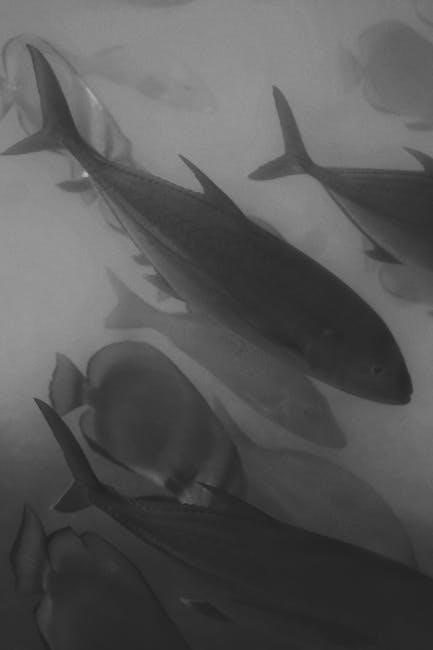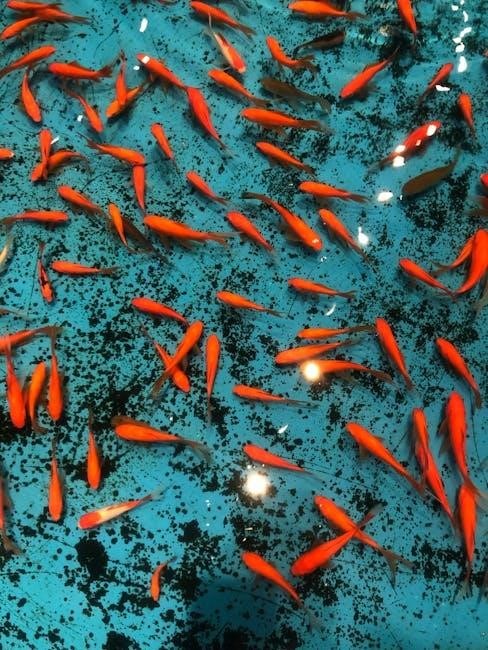Queensland’s fishing regulations ensure sustainable practices by setting size, bag, and possession limits. These laws protect fish populations and maintain biodiversity. The Qld Fishing 2.0 app and printed guides provide easy access to these rules, helping anglers stay compliant and promote conservation.
Overview of Queensland’s Fishing Laws
Queensland’s fishing laws are designed to conserve fish populations and promote sustainable fishing practices. These regulations include size limits, bag limits, and possession limits, which vary by species and fishing location. Minimum and maximum size limits protect juvenile fish and large, reproductive individuals, ensuring the long-term health of fish stocks. Possession limits restrict the number of fish anglers can keep, preventing overfishing. The laws apply to both tidal and freshwater areas, with specific rules for different species. Regular updates to these regulations ensure they remain effective in managing fish populations. Anglers must stay informed to comply with the latest rules, which are easily accessible via the Qld Fishing 2.0 app or printed guides. Adhering to these laws helps maintain biodiversity and ensures fishing remains a sustainable activity for future generations.

Importance of Adhering to Size and Possession Limits
Adhering to size and possession limits is vital for maintaining healthy fish populations and ensuring sustainable fishing practices in Queensland. These limits protect juvenile fish, allowing them to mature and reproduce, while also safeguarding large, ecologically important individuals. Exceeding possession limits or retaining undersized fish can lead to penalties and harm the environment. Compliance helps balance recreational and commercial fishing with conservation efforts. By following these rules, anglers contribute to the long-term health of marine and freshwater ecosystems. Accurate measurement and awareness of species-specific limits are essential for responsible fishing. Staying informed through resources like the Qld Fishing 2.0 app or printed guides ensures anglers can fish legally and ethically, preserving Queensland’s fisheries for future generations.

Key Components of QLD Fish Size Limits
QLD fish size limits include minimum and maximum sizes for species like Australian Bass and Barramundi, ensuring sustainable fishing. The Qld Fishing 2.0 app and guides detail these rules.

Minimum Size Limits for Popular Species
Queensland imposes minimum size limits to protect juvenile fish, ensuring they mature before being caught. Popular species like Australian Bass require a minimum size of 30 cm, while Barramundi must be at least 58 cm in tidal waters. These limits vary by species and location, with some fish like the Australian Lungfish being entirely protected. Accurate measurement is crucial, with guidelines specifying how to measure from the snout to the tail fin. Anglers must adhere to these limits to avoid penalties and support sustainable fishing practices. Checking the latest regulations via the Qld Fishing 2.0 app or printed guides ensures compliance and helps conserve fish populations for future generations.
Maximum Size Limits for Specific Fish

Maximum size limits in Queensland are implemented to protect larger, mature fish that play vital roles in maintaining ecosystem balance. For example, Barramundi has a maximum size limit of 120 cm in some areas, while other species may have specific restrictions. These limits ensure that key breeding individuals are not removed, preserving the genetic diversity and sustainability of fish populations. Anglers must release any fish exceeding these maximum size limits to comply with regulations. These limits vary by species and location, with detailed information available in the Queensland recreational fishing guide or the Qld Fishing 2.0 app. Adhering to these limits helps conserve fish stocks and supports responsible fishing practices.
Possession Limits in Queensland Waters
Possession limits restrict the total number of fish you can legally possess, including those stored at home. Exceeding these limits is illegal and harms conservation efforts.
Bag Limits for Recreational Fishing
Bag limits in Queensland waters are designed to ensure sustainable fishing practices while allowing recreational anglers to enjoy their catch; These limits vary by species and fishing location, with specific rules for tidal and freshwater areas. For example, certain species like Australian Bass and Bream have a daily bag limit, while others may have stricter or more lenient restrictions. It is important to note that possession limits often apply in addition to bag limits, meaning the total number of fish you can legally possess includes those stored at home. Exceeding these limits can result in penalties, so checking the latest regulations via the Qld Fishing 2.0 app or printed guides is essential. Adhering to bag limits helps protect fish populations and ensures the long-term sustainability of Queensland’s fisheries.
Total Possession Limits for Fish and Crustaceans
Total possession limits in Queensland regulate the maximum number of fish and crustaceans an individual can legally possess at any time. These limits apply to all fish, including those stored at home in freezers or on a boat. For some species, like Australian Bass and Blue Swimmer Crab, the possession limit is double the daily bag limit, allowing anglers to store catches over multiple days. However, for many other species, the possession limit mirrors the daily bag limit, meaning only the amount caught in one day can be kept. Exceeding these limits can result in penalties. It is crucial to understand that possession limits are cumulative and apply to all locations, including home storage. Always refer to the Qld Fishing 2.0 app or printed guides for species-specific details to ensure compliance with Queensland’s fisheries regulations.

Measurement Guidelines for Fish
Fish must be measured from the tip of the upper jaw to the end of the tail. Use a flexible measuring tape for accuracy. Garfish and whiptail have specific measurement rules.
Accurate Measurement Techniques
Accurate measurement of fish is essential for compliance with Queensland’s fishing regulations. Fish should be measured from the tip of the upper jaw to the end of the longest tail lobe. For species with forked tails, measure to the longest lobe, while rounded or pointed tails are measured to the furthest point. Use a flexible measuring tape to ensure precision. Lay the fish flat and straight during measurement to avoid inaccuracies. Special species, like garfish, are measured from the tip of the upper jaw to the end of the tail, while whiptail is measured to the shorter tail’s end. Always refer to official guides or the Qld Fishing 2.0 app for specific species guidelines and visual aids to ensure correct measurements and avoid penalties.

Special Considerations for Different Species
Certain species in Queensland require unique measurement methods. For example, garfish are measured from the upper jaw tip to the tail end, while whiptail fish are measured to the shorter tail’s end. Additionally, all scale-bearing fish not listed in the regulations must be at least 30cm, with a bag limit of 5 per species and a total of 20. Coral reef finfish have specific legal size and possession limits, and some species, like Australian lungfish, are protected and cannot be taken. Understanding these special considerations ensures compliance with regulations and helps preserve species diversity. Always consult the Queensland recreational fishing guide or the Qld Fishing 2.0 app for detailed instructions tailored to each species.
Accessing QLD Fish Size Limits Information
Queensland fish size limits are detailed in the Qld Fishing 2.0 app and printed guides. These resources provide up-to-date regulations, ensuring anglers stay informed and compliant with local laws.
Downloading the Qld Fishing 2.0 App
The Qld Fishing 2.0 app is a user-friendly tool available for free download on the App Store and Google Play. It provides instant access to Queensland’s fishing regulations, including size and possession limits, species identification, and closed seasons. Anglers can use the app to search for specific fish or browse the entire database, ensuring compliance with local laws. The My Fishing feature allows users to log trips, record catches, and share photos, enhancing the fishing experience. Additionally, the app enables reporting of illegal fishing activities directly to authorities. Regular updates ensure the information stays current, making it an essential resource for responsible and sustainable fishing practices in Queensland.

Obtaining Printed Guides
Printed copies of Queensland’s recreational fishing guide are available for those who prefer a physical resource or lack consistent internet access. These guides provide detailed information on size, bag, and possession limits, ensuring compliance with fishing regulations. To obtain a printed guide, visit your nearest Queensland Boating and Fisheries Patrol office or call 13 25 23 for assistance. For larger quantities, such as for clubs or organizations, printed guides can be ordered online through the Queensland government’s website. These guides are updated regularly and serve as a reliable backup for digital users or a primary source for those without smartphones. They are essential for maintaining a sustainable and enjoyable fishing experience in Queensland.
Staying Updated on Regulatory Changes
Staying informed about changes to Queensland’s fishing regulations is essential for responsible angling. The Queensland government regularly updates size and possession limits to ensure sustainable fish populations. To stay updated, download the Qld Fishing 2.0 app, which provides real-time regulatory information. Additionally, visit the Queensland Department of Agriculture and Fisheries website for the latest guides and updates. You can also contact Fisheries Queensland directly through the app or by calling 13 25 23 for clarification on specific rules. Regularly checking these sources ensures compliance with the most current regulations, helping to protect fish stocks and maintain the integrity of Queensland’s waterways for future generations.
Queensland’s fishing regulations are vital for maintaining healthy fish populations and ensuring sustainable fishing practices. By adhering to size, bag, and possession limits, anglers play a crucial role in conservation. The Qld Fishing 2.0 app and printed guides provide essential resources for staying informed. Regular updates and accurate measurements are key to compliance. Responsible fishing practices not only protect the environment but also ensure the longevity of recreational fishing for future generations. Always check the latest regulations before your next fishing trip and report any illegal activities to support Queensland’s waterway health.



